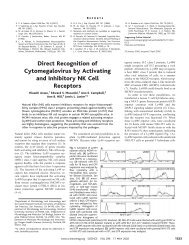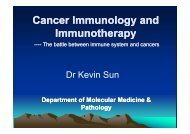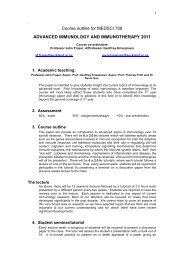Topic 2 lecture note..
Topic 2 lecture note..
Topic 2 lecture note..
You also want an ePaper? Increase the reach of your titles
YUMPU automatically turns print PDFs into web optimized ePapers that Google loves.
abnormalities in postsurgical leukocyte rolling in cremaster venules. Antibodies blocking<br />
L-selectin function reduced rolling in CD34 deficient mice suggesting that CD34 lacks<br />
major significance as a ligand for L-selectin.<br />
**************************************************************************************<br />
Chemoattractants<br />
Extracellular matrix<br />
In a lot of the connective tissues, the extracellular matrix molecules are secreted by cells<br />
called fibroblasts. These molecules assemble into the extracellular matrix once they are<br />
secreted. The extracellular matrix is made up of two classes of macromolecules. The first<br />
class is called glycosaminoglycans, which are polysaccharide chains. Members of this<br />
class are usually found to be covalently linked to protein in the form of proteoglycans.<br />
The second class is made up by fibrous proteins. There are two functional types of<br />
fibrous proteins: the ones that are mainly structural, like collagen and elastin for example,<br />
and the ones that are mainly adhesive, like fibronectin and laminin for example. The<br />
members of the glycosaminoglycans form a highly hydrated, gel-like substance, in which<br />
the members of the fibrous proteins are embedded. Collagen fibers strengthen and help to<br />
organize the matrix, while elastin fibres give it resiliance. The adhesive proteins help<br />
cells to attach to the extracellular matrix. Fibronectin for example promotes the<br />
attachment of fibroblasts and other cells to the matrix in connective tissues via the<br />
extracellular parts of some members of the integrin family, while laminin promotes the<br />
attachment of epithelial cells to the basal lamina, again via the extracellular domains of<br />
some members of integrins.<br />
**************************************************************************************<br />
Multistep process of leukocyte extravasation<br />
The stimulus for endothelial activation in vivo is probably local production of cytokines<br />
and other inflammatory mediators released on tissue injury.<br />
Capture<br />
The process known as capture or tethering represents the first contact of a leukocyte with<br />
the activated endothelium. Capture occurs after margination, which allows leukocytes to<br />
move in a position close to the endothelium, away from the central blood stream. During<br />
the inflammatory response, endothelial activation is required to initiate capture.<br />
P-selectin on endothelial cells, is the primary adhesion molecule for capture and the<br />
initiation of rolling. The main leukocyte ligand for P-selectin is PSGL-1. In addition,<br />
many in vivo studies suggest that L-selectin exhibits an important role in capture as well.<br />
Antibodies blocking L-selectin function inhibit rolling in many models in which rolling is<br />
P-selectin dependent.<br />
EFigure 10. Expression of ICAM-3 (CD50)<br />
E-cadherin.10)





